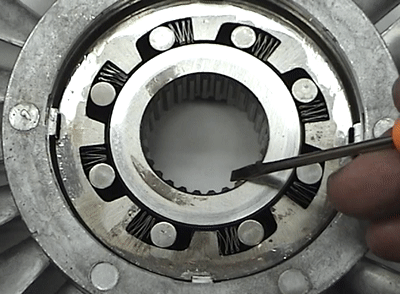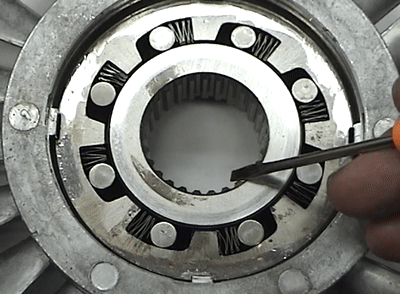A one-way bearing is a kind of bearing that can rotate freely in one direction and lock in the other direction.
The metal shell of a one-way bearing contains a lot of rollers, needles or balls, and the shape of its rolling seat makes it only roll in one direction, and it will produce a lot of resistance in the other direction (the so-called “single Towards”).
 1. Working principle of one-way bearing
1. Working principle of one-way bearing
In fact, regardless of the structure of the one-way bearing, its principle is the clamping principle, which can be divided into:
Slope and roller type:
Here the outer ring of the bearing is the same as the ordinary bearing, which is a cylindrical outer ring. But its inner ring structure is more special, its inner ring is a circle with a slope.
In addition, it has rollers that are always in contact with the inner and outer rings and springs that are in contact with the rollers. The working surface of the roller is a slope. When the bearing rotates along, the roller is in a downslope state. There is a large space at the downslope and the roller will not be affected.
When reverse rotation, the roller is uphill, the uphill is relatively narrow, the roller is stuck, the bearing is locked.
Another one-way bearing structure is a wedge structure:
In this type of bearing, a set of cam wedges are set between the inner ring and the outer ring of the bearing. The cam has two diameters of different sizes. The long warp is larger than the distance between the inner ring and the outer ring, and the short warp is smaller than the distance between the inner ring and the outer ring of the bearing.
A cylindrical winding spring is connected end to end between the wedges to form an annular spring arranged on the fulcrum of the wedge, and the wedge can be reset by the action of the spring.
2. Installation of one-way bearing
Since the one-way bearing is rust-proofed and packaged, do not open the package before installation. The anti-rust oil coated on one-way bearings has good lubrication performance. For general-purpose one-way bearings or one-way bearings filled with grease, it can be used directly without cleaning.
The installation method of one-way bearing varies with bearing type and matching conditions.
Since generally shaft rotation is used, the inner ring and outer ring can adopt interference fit and clearance fit respectively, and when the outer ring rotates, the outer ring adopts interference fit.
(1) Press-in installation
Press-in installation generally uses a press, bolts and nuts can also be used, and a hand hammer can be used for installation when necessary.
(2) Hot sleeve installation
The heat sleeve method of heating the one-way bearing in oil to expand it and then installing it on the shaft can prevent the one-way bearing from being subjected to unnecessary external forces and complete the installation in a short time.
Let me just say a digression here. Some one-way bearing catalogues do have models, but some non-standard one-way bearings are not available in mainland China. Sometimes the futures will be long, so when selecting one-way bearings Consider the time cost and the cost of later replacement.
2. Overhaul and maintenance of one-way bearings
Generally, the maintenance of one-way bearings requires several steps, including:
1. Look
To look at the one-way bearing is to observe whether the one-way bearing is rusty, whether the one-way bearing has broken lines, and whether the one-way bearing is peeled off.
2. Listen
Listen to whether there is noise in the one-way bearing and whether the noise of the one-way bearing is normal.
3. Diagnosis
Use equipment for diagnosis, such as electronic diagnostic equipment, stethoscopes, etc.
The maintenance work is similar to that of other bearings. The relative movement of the rolling elements and raceways and the intrusion of pollutants and dust cause wear on the surfaces of the rolling elements and raceways. Affect the accuracy of the host.
When checking or replacing parts regularly, the one-way bearing needs to be disassembled. Usually shafts and bearing boxes are almost always used, and one-way bearings are often used. Therefore, the structural design should take into account that the bearing, shaft, bearing box and other parts will not be damaged when disassembling the bearing. At the same time, appropriate disassembly tools should be prepared. When disassembling a statically fitted ferrule, only the tension can be applied to the ferrule, and the ferrule must not be pulled through the rolling elements.
One-way bearings are widely used in textile machinery; printing machinery; automotive industry; household appliances; currency detectors.
The invention of the one-way bearing solves many mechanical problems that need to be prevented from reversing. It has played a big role in many household appliances such as washing machines. In some conveying machinery, such as the transportation of materials, it can effectively prevent materials from falling back.
Therefore, the standardized structure makes it unnecessary for many machines to design a special anti-reverse structure separately, which saves a lot of manpower and material resources. Therefore, the future prospects for the development of one-way bearings are very broad.
Post time: Nov-17-2021

